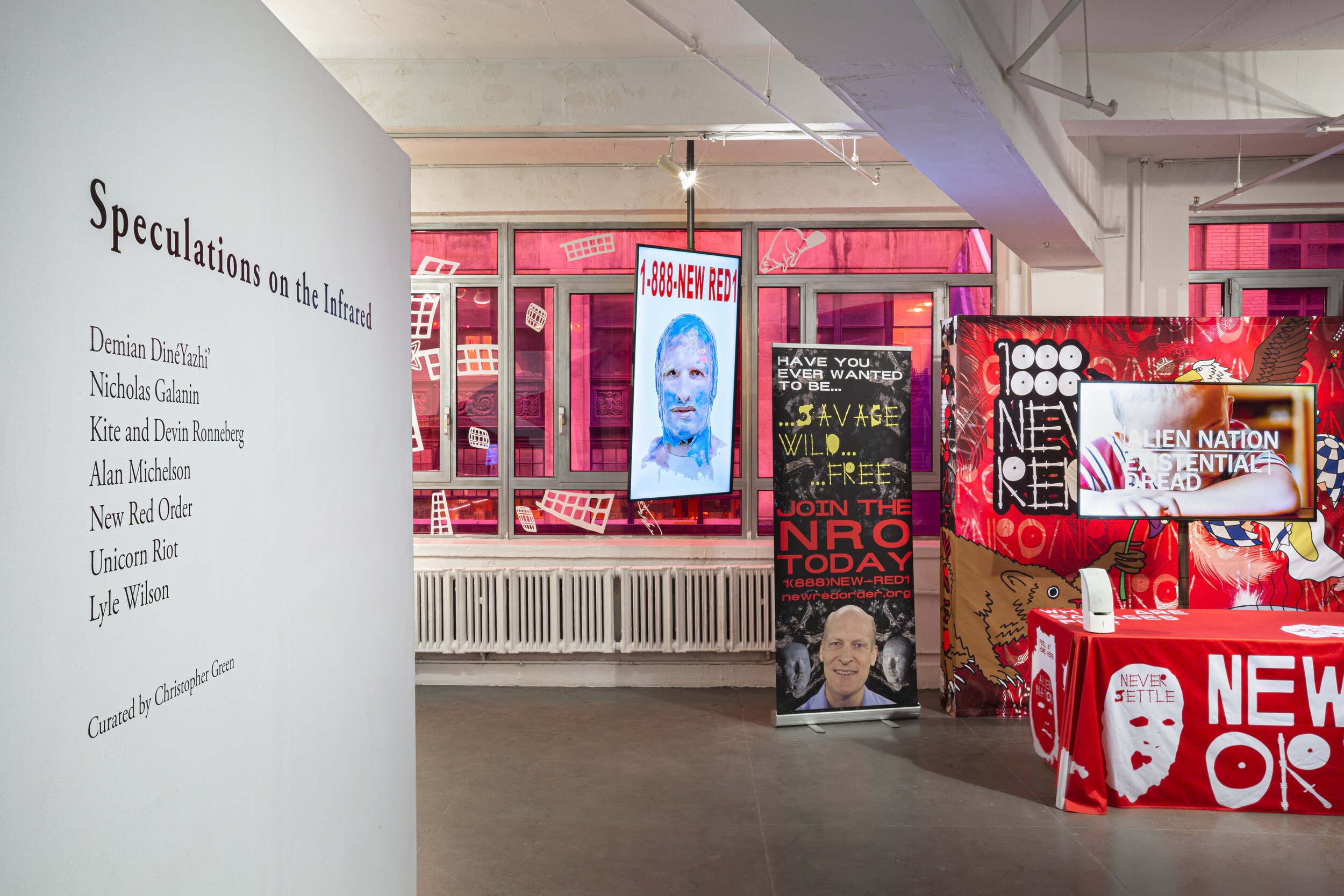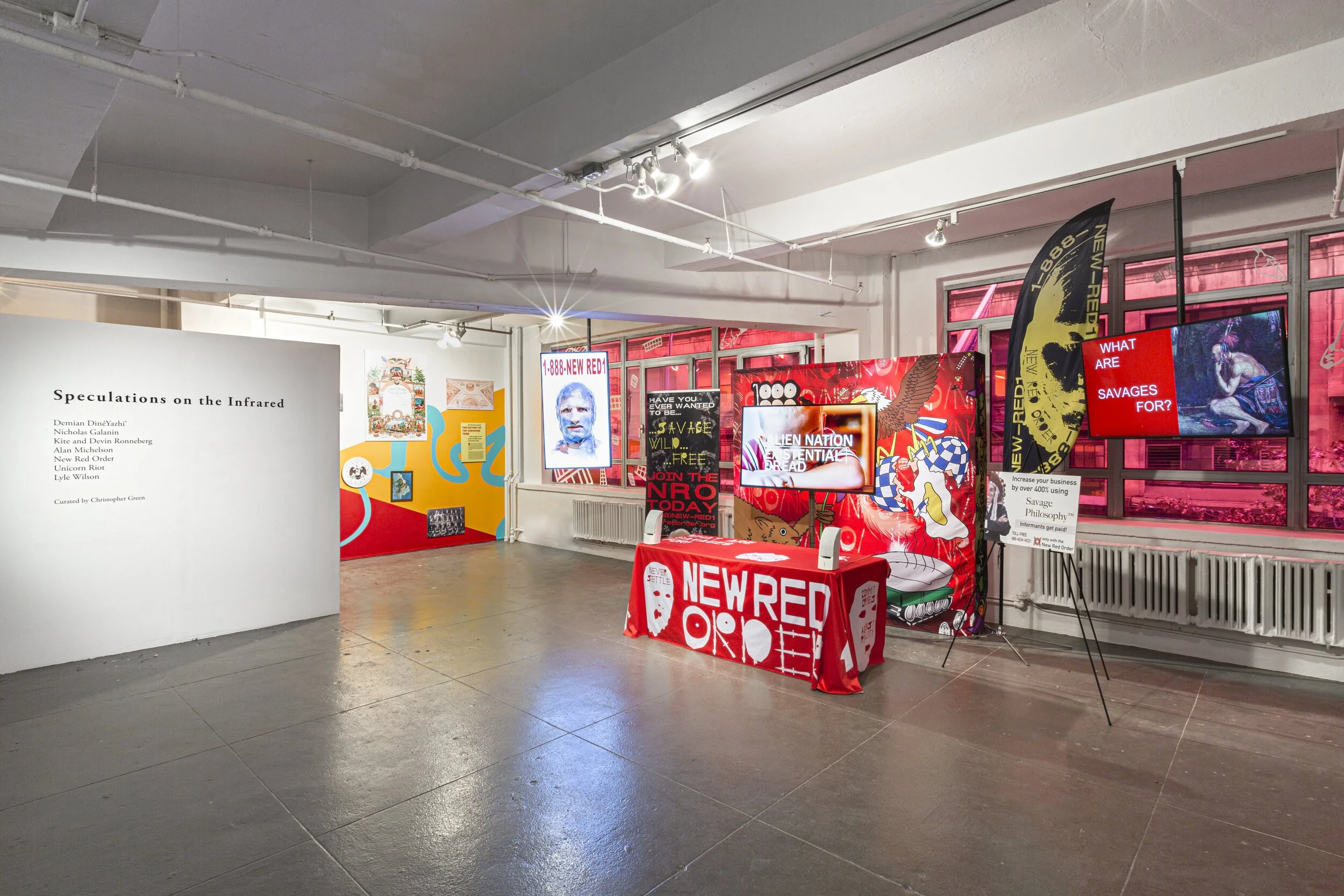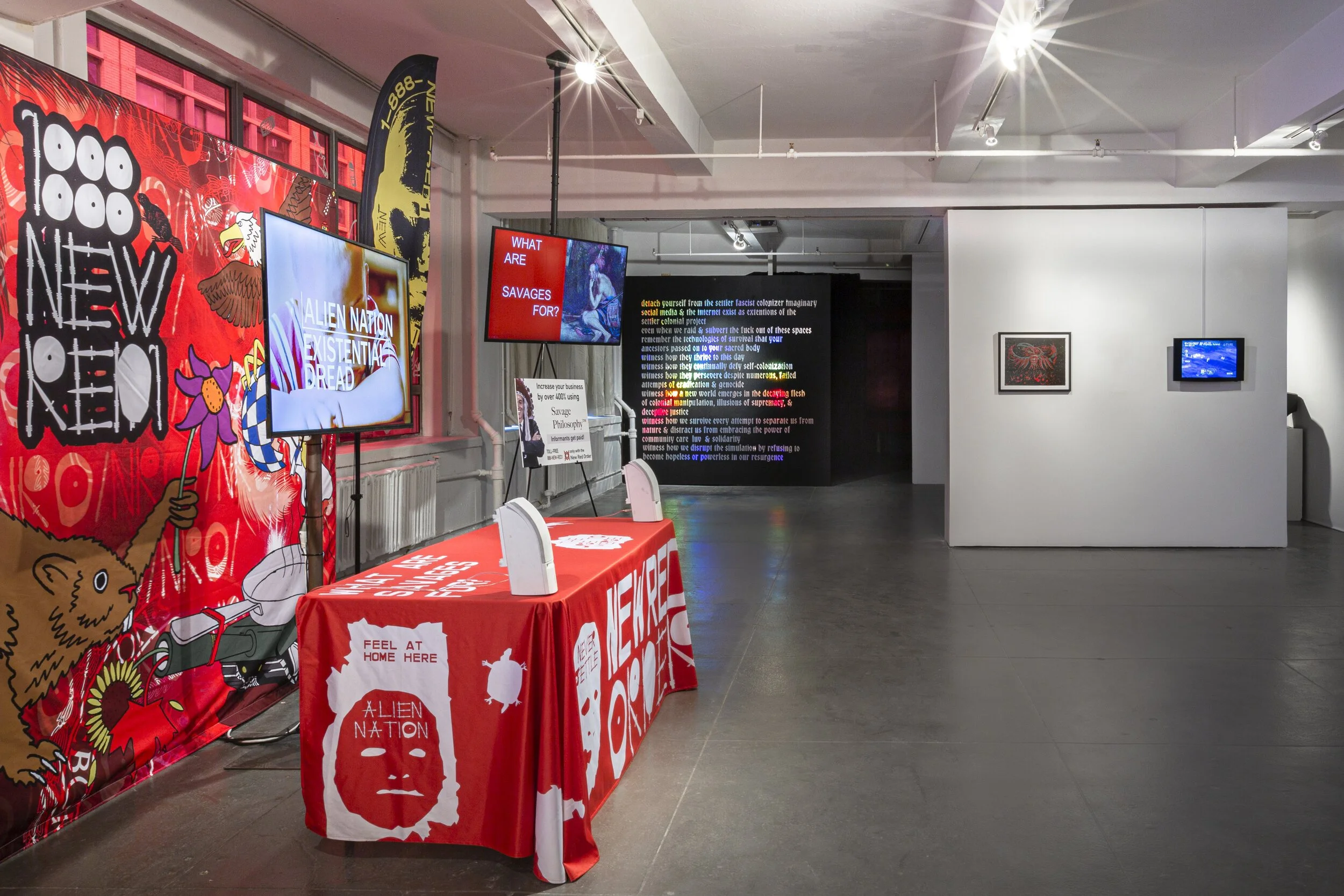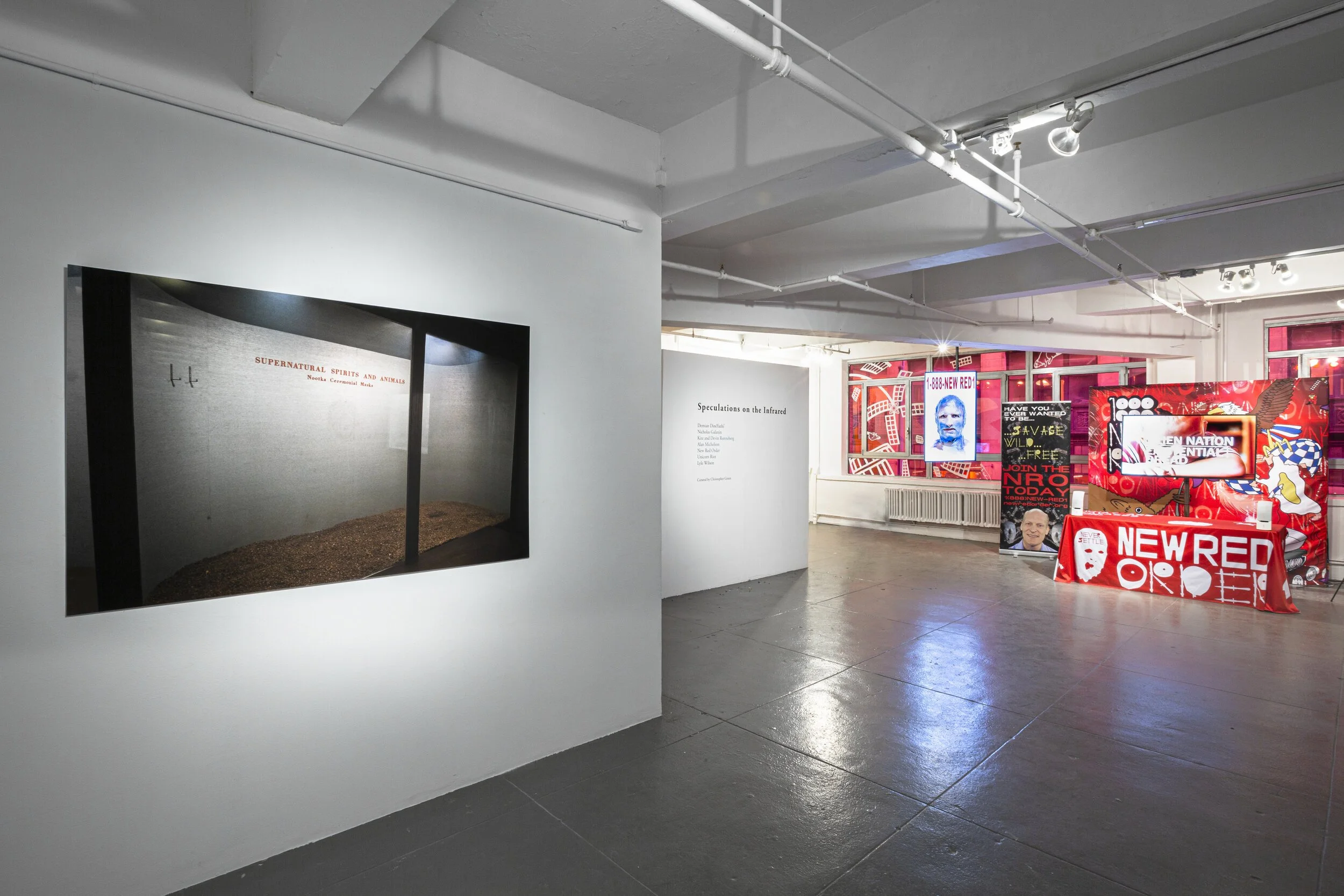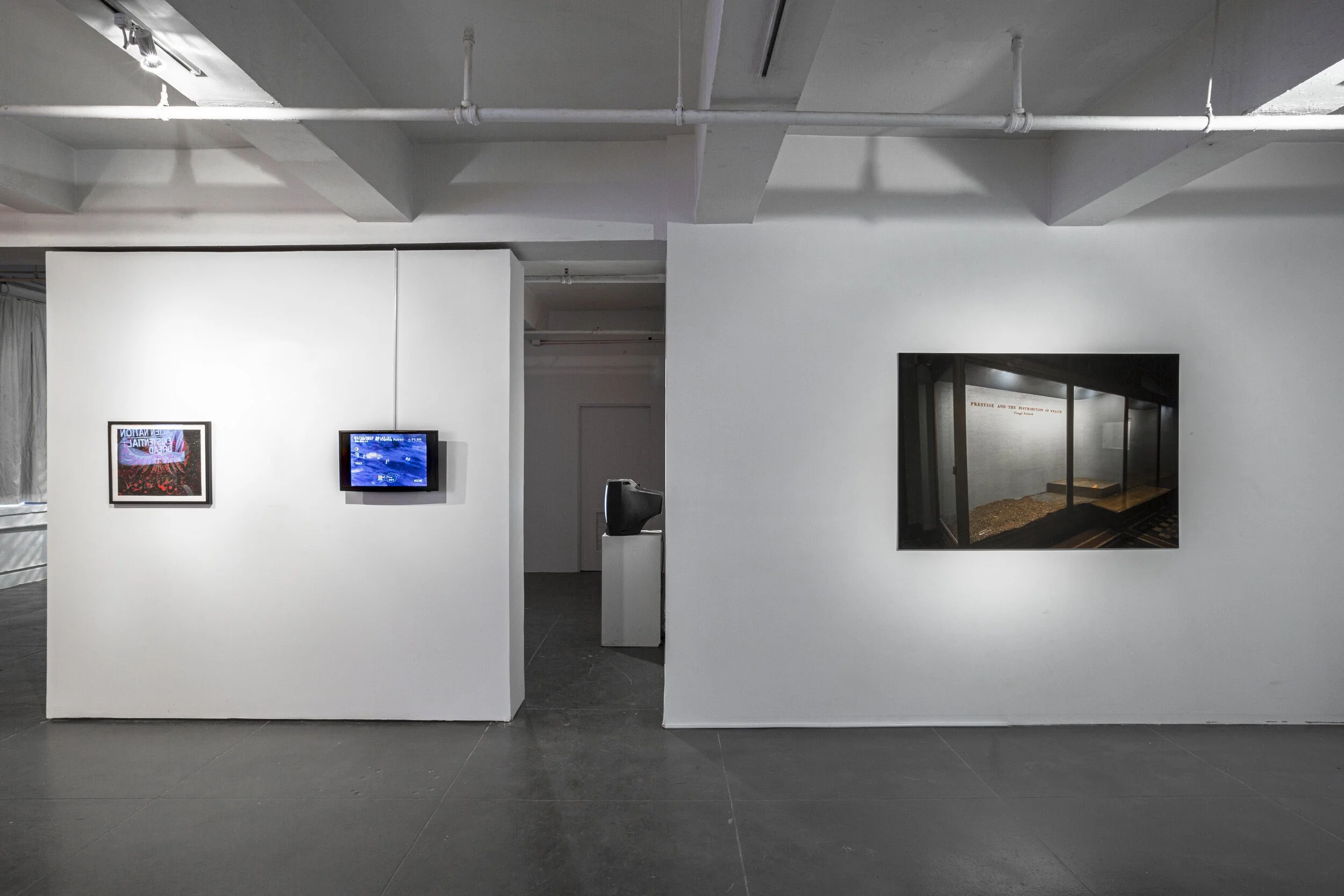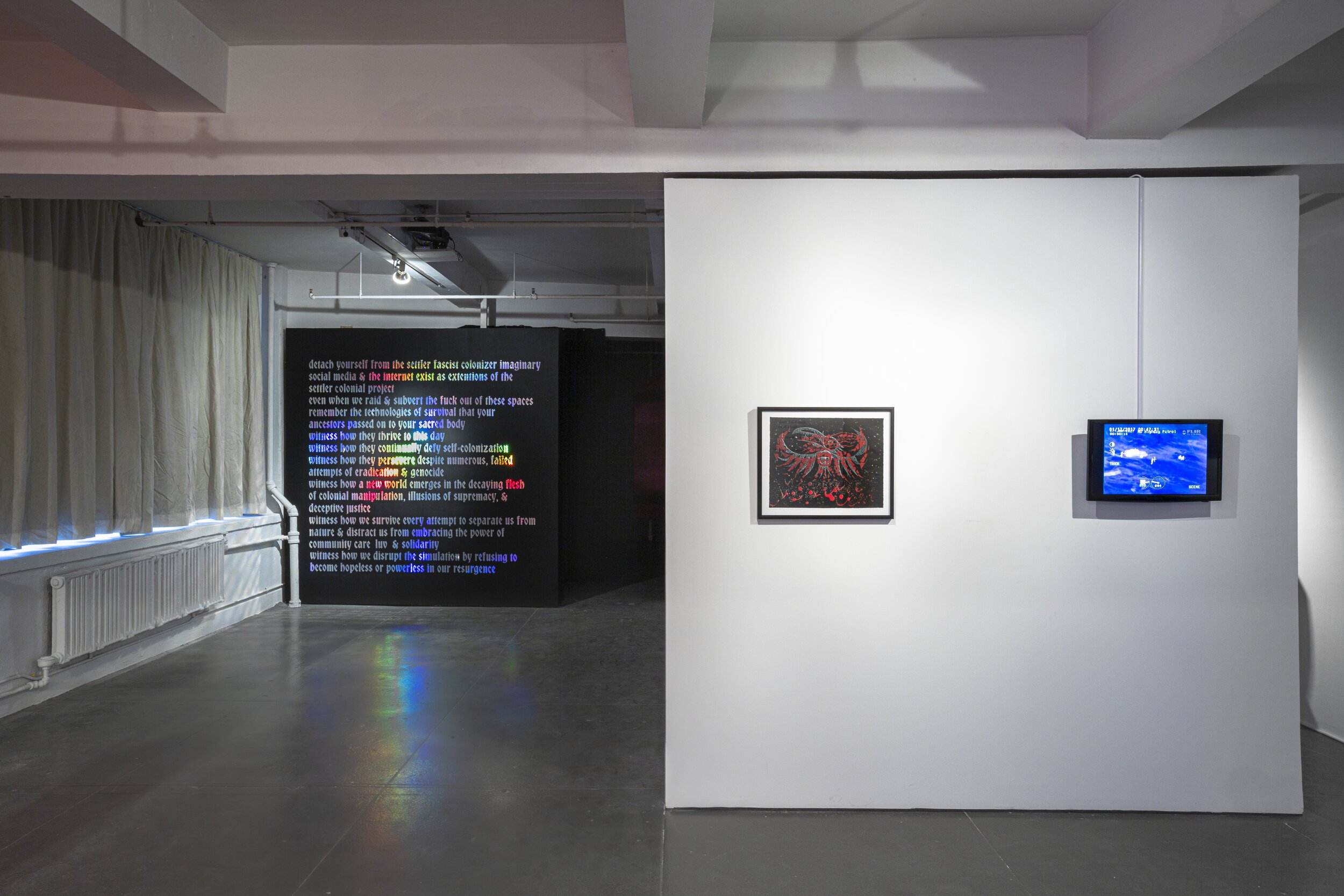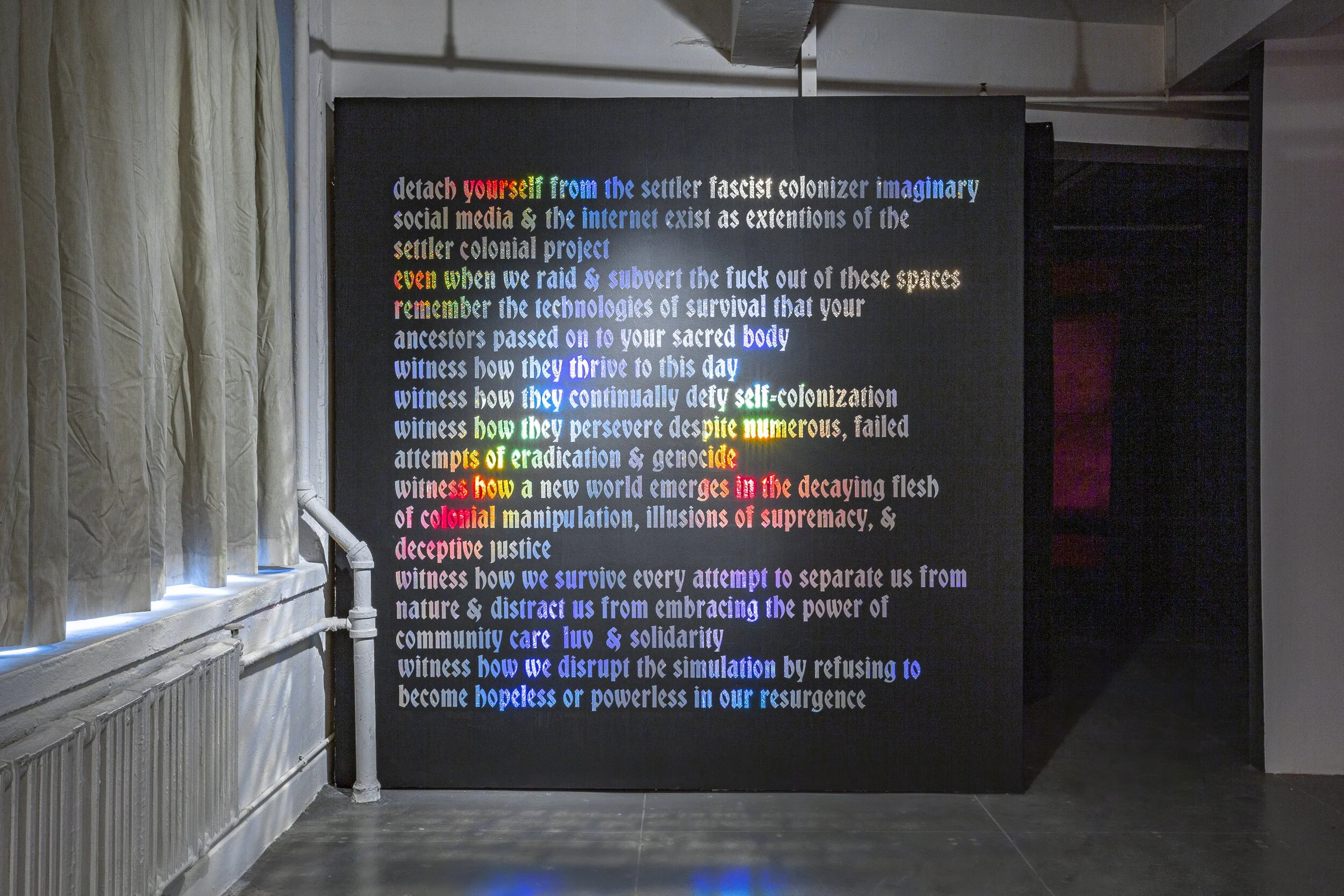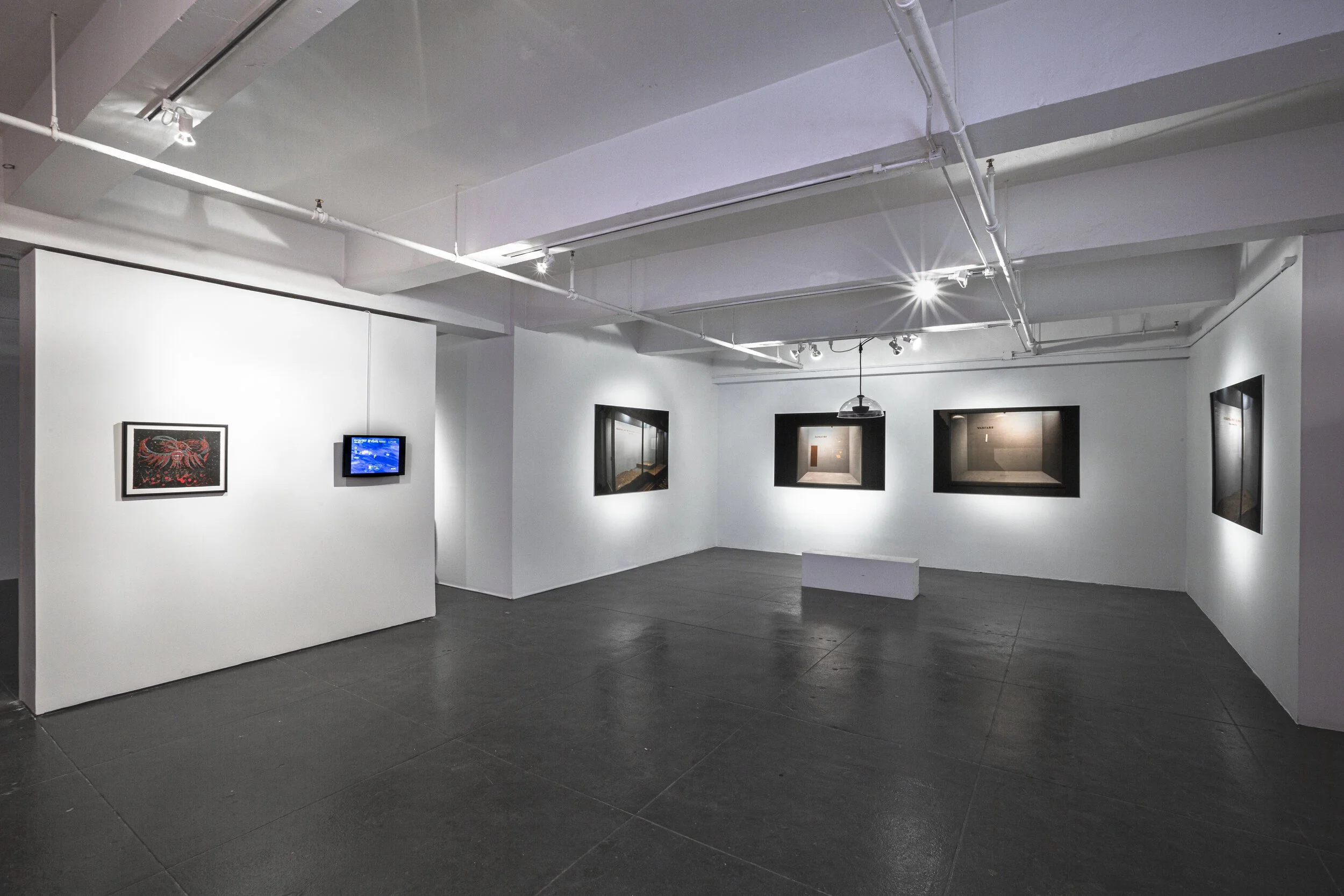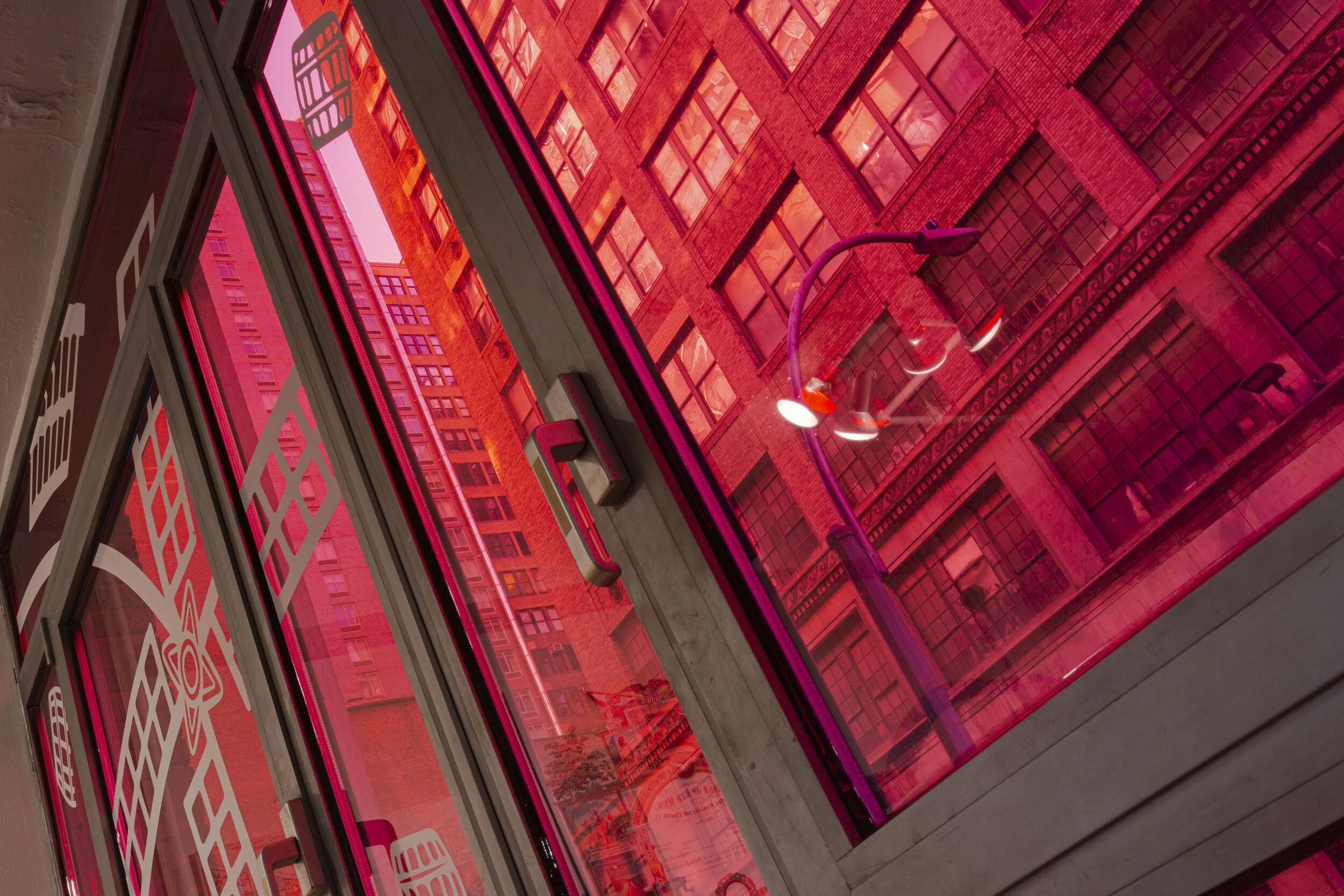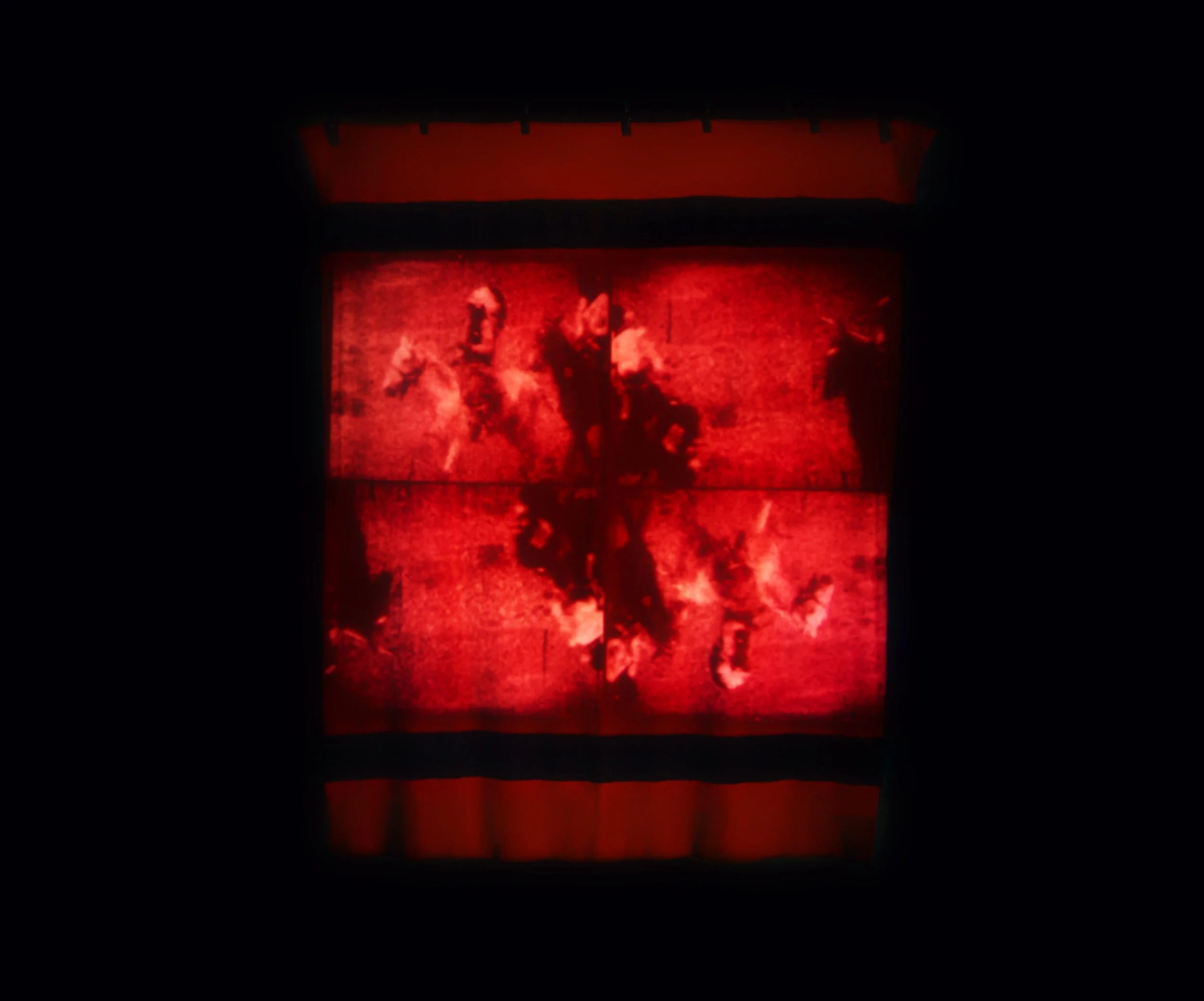Speculations on the Infrared
January 30–March 6, 2021
Curated by Christopher Green
Demian DinéYazhi'
Nicholas Galanin
Kite and Devin Ronneberg
Alan Michelson
New Red Order
Unicorn Riot
Lyle Wilson (Haisla)
Speculations on the Infrared explores tactics of speculative Indigenous futurism that foreground and redeploy the subsumed and repressive nature of the settler state’s relationship to colonized peoples as a potential tool of sovereignty. Considering infra- as “below,” as in the spectrum below visible light, but also that which is “further on,” the works in this exhibition speculate on the latent desires for Indigeneity and the subaltern Indigenous DNA of the settler national identity and mythos. Considering how such undercurrents might be aestheticized while viewing celebrations of visibility and inclusions with skepticism, the contributors imagine how sovereign structures, relations, and visions might be erected upon the rubble of what is, from an Indigenous perspective, already a post-apocalyptic colonial landscape.
While Indigenous futures, pasts, and presents intermingle and manifest in many material and visual forms, those which recognize and unearth the buried strata of despoiled treaty relations, fabricated secret societies, and rampant cultural extraction that found the settler colonial condition are best suited to propose new sovereign structures to build upon the colonial detritus. Working from the premise that Indigeneity underpins the colonial nation state’s identity formation and its most base cultural desires, the work in Speculations on the Infrared suggests that there is a strategic decolonial position to be gained from that subaltern power.
EVENTS
Saturday, February 6, 7-9 PM
Speculations on the Infrared - Virtual Opening Reception
Tuesday, February 16, 7:30-8:30 PM
A reading by Demian DinéYazhi' and Alán Peláez López
Tuesday, February 23, 1-2 PM
Speculations Correspondents Hour: A Conversation with Anne Spice
Exhibition Photography © EFA Project Space/Yann Chashanovski
Lyle Wilson (Haisla), Untitled #1, 1986. Silkscreen and lithograph, 15 x 19 in. Image courtesy the artist and Inuit Gallery of Vancouver. Image description: The figure of a bird with its wings outstretched painted in a metallic shade. It floats on a black backdrop, with a second set of wings, in blood red hues, overlaying the first one. There are yellow and red splatter marks along the bottom third of the image.
A reading by Demian DinéYazhi' and Alán Peláez López
RESOURCES
PRESS
Harry Burke, Speculations on the Infrared, Art-Agenda, 15 Mar 2021
Ian Bourland, Countering the Fetishization of Indigenous Art, Frieze, 18 Mar 2021
ABOUT BRIGHT FUTURES
Project Space’s 2021 programming season is dedicated to Bright Futures, envisioning a radical push for transparency, equality, and justice through exhibitions and artist projects that grapple with key political and social issues including racial capitalism, digital surveillance, mobility and access, gender, toxic masculinity, transition, multi-species repair, and ecological crisis. After a year of forced reckoning with America’s broken healthcare systems, the plague of systemic racism and violence, and deep class and gender divides, Bright Futures will connect the work of artists and communities that are united in sparking action and dialogue for changemaking. Taking a prompt from the conceptual frameworks of artist (and Project Space advisor) Lukaza Branfman-Verissimo, Bright Futures counters the current mood of political, social, and ecological despair. Expanding outward from Project Space’s renewed mission, the 2021 season will spotlight art that is community-based and future-looking, revealing contemporary practices that engage with technology and society, politics and poetics, and fuse belief and praxis in the promise of a better world.
New Red Order, Never Settle, 2018-ongoing. Digital video, 49:32 and Recruitment Station, 2020-21, with Gaile Pranckunaite, Inpatient Press, and Emmett de Muzio. Nylon banners, polyester table cloth, foam board, video monitors, cut white vinyl over red translucent window covering. Dimensions variable. Read more here.
[Image Description: A view of the Project Space gallery as you enter. A former manufacturing space, the gallery shows residual traces of its industrial past – grey-painted concrete floors, white concrete beams running along the ceiling, industrial radiators and conduits. An eight-foot high white wall with the exhibition title and list of contributing artist names in black serif lettering is on the left side of the image. On the right side of the image, set farther back, is a partial view of the work of New Red Order. The New Red Order work consists of an installation of a six-foot long table with a red drop cloth decorated with white designs, including slogans like Never Settle and masked faces. One of two white audio speakers is placed on the table. A large video monitor is mounted on a stand directly behind the table and displays a video program from the New Red Order. Behind that, a nearly eight by eight foot banner depicts a cartoonish beaver holding a flower and an eagle cracking an egg in front of a modulated red and black background with the words New Red and letters N R O repeated across its surface. A black vertical banner to the left of the eight by eight banner depicts the smiling face of a white actor and the words Join the N R O Today. A vertical video monitor hangs from the ceiling to the left of the vertical banner with a shoulder-length view of a human wearing a blue and clear silicon mask with a phone number 1-888-NEW RED1 on the screen. The installation is immediately in front of a the gallery’s windows which are covered in red transparencies and white vinyl deigns of windmills, beavers, and barrels.]
New Red Order, Never Settle, 2018-ongoing. Digital video. 49:32.
New Red Order, Recruitment Station, 2020-21, with Gaile Pranckunaite, Inpatient Press, and Emmett de Muzio. Nylon banners, polyester table cloth, foam board, video monitors, cut white vinyl over red translucent window covering. Dimension variable.
New Red Order, Progenerator, 2020-21, with Virgil B/G Taylor. Wall mural, prints, video monitors, video loop, found objects (porcelain plate, nylon ribbon, brass medal, painting in wooden frame). Dimensions variable.
[Image Description: A wider view of the entrance to the gallery, with the exhibition title wall and New Red Order installation framing a viewing alcove in the center of the image. In the viewing alcove a turquoise meandering line is painted on the back wall of the gallery over white, yellow, and red triangular sections as part of the New Red Order’s wall installation titled Progenerator. The New Red Order Recruitment Station installation is visible on the right side of the image, including the table, video monitors, banners, and transparency and vinyl covered windows.]
[Image Description: An installation image of the gallery as you move forward from the entrance almost to the windows then turn right. The left side of the image includes the New Red Order installation of banners, table, and video monitors in the foreground. In the center of the image, a eight by nine foot wall that is painted black separates the viewer from the darkened back space of the gallery. Silver reflective vinyl lettering by Demian DineYazhi’ is installed on the black wall facing the camera. The vinyl reflects a rainbow shimmering light, making the words appear multicolored. Another eight by nine foot freestanding white wall occupies the middleground of the right side of the image almost halfway between the New Red Order table and the back wall. On the left side of the wall, vertically centered, is a framed print by Haisla artist Lyle Wilson. It depicts the figure of a stylized bird in a metallic shade on a black backdrop, with a blood-red fragmented figure of the bird overlaying the first one, their two colors dotting the image like faraway lights and bloodstains. A video monitor is hung at level to the print on the right side of the wall and shows a grayscale still from infrared surveillance footage of the #NODAPL protests at Standing Rock from the media collective Unicorn Riot, with a car and human figures visible as bright white outlines.]
Nicholas Galanin, Fair Warning: A Sacred Place, 2019. Photographic prints and audio. 44 x 64 in each.
[Image Description: A rectangular gallery with grey concrete floors and white walls, with many industrial pipes and track lights running across the white ceiling. At left, the freestanding white wall with Lyle Wilson’s red and black print of a stylized bird and the video monitor with Unicorn Riot’s infrared surveillance footage. Three white walls form a rectangular space directly to the left of the entrance, with four photographs by Nicholas Galanin hung flat on the walls. Each photograph depicts a glass display case inside a darkened museum exhibition hall. Inside each case are red words displayed on the fabric-wrapped walls. A sound cone hangs from the ceiling in the middle of the rectangular area, and a white bench rests on the ground directly beneath it.]
Lyle Wilson, Untitled #1, 1986. Silkscreen and lithograph print. 15 x 19 in.
Unicorn Riot, Infrared Aerial Surveillance from Standing Rock, 2016-2017, 2019. Digital video. 1:57:48.
Nicholas Galanin, Fair Warning: A Sacred Place, 2019. Photographic prints and audio. 44 x 64 in each.
[Image Description: An installation image of the gallery as you move forward from the entrance into the middle of the room then turn right. The image is evenly split between the white wall at left featuring Lyle Wilson’s red and black print of a stylized bird and the video monitor with infrared footage and a larger white wall at right that features a photograph by Nicholas Galanin of a lit empty glass display case inside a darkened museum exhibition hall. The display case has wood chips on the floor and a wooden bench is directly outside the case. Inside the case the words Prestige and the Distribution of Wealth Tlingit Potlatch are displayed on its fabric-wrapped walls. In the center of the image, a black C R T television from the 1990s that is part of Kite and Devin Ronneberg’s multimedia installation is visible through a two-foot gap between the walls, standing on a three foot tall white rectangular plinth, its screen illuminated and drawing the viewer forward.]
Demian DinéYazhi’, disrupt the settler colonial simulation, 2020. Reflective vinyl wall installation. 108 x 108 in. Read more here.
Lyle Wilson, Untitled #1, 1986. Silkscreen and lithograph print. 15 x 19 in. Read more here.
Unicorn Riot, Infrared Aerial Surveillance from Standing Rock, 2016-2017, 2019. Digital video. 1:57:48. Read more here.
[Image Description: An installation image of the gallery, moving closer towards the freestanding wall in the center of the rectangular gallery space. The image is evenly split between Demian DineYazhi’s rainbow vinyl wall installation and the white wall featuring Lyle Wilson’s red and black print of a stylized bird and the video monitor playing infrared surveillance footage. A beige curtain hangs over the window to the left of the black wall with reflective vinyl lettering, blocking external sunlight.]
Demian DinéYazhi’, disrupt the settler colonial simulation, 2020. Reflective vinyl wall installation. 108 x 108 in. Read more here.
[Image Description: An installation view of a black wall with reflective silver vinyl text that spells out a wall text installation by the artist Demian DineYazhi. The prismatic qualities of the vinyl cause it to reflect rainbow colors, making the words appear multicolored and rainbow colors to shine on the floor in front of the piece and on the wall and curtains to the left of the piece. To the left of the wall, a three foot gap leads into a darkened space at the back of the gallery, through which a hanging red blanket is partially visible and faintly illuminated. The text on the wall reads: detach yourself from the settler fascists colonizer imaginary social media and the internet exist as extensions of the settler colonial project even when we raid and subvert the fuck out of these spaces remember the technologies of survival that your ancestors passed on to your sacred body witness how they thrive to this day witness how they continually defy self-colonization witness how they persevere despite numerous, failed attempts of eradication and genocide witness how a new world emerges in the decaying flesh of colonial manipulation, illusions of supremacy, and deceptive justice witness how we survive every attempt to separate us from nature and distract us from embracing the power of community care luv and solidarity witness how we disrupt the simulation by refusing to become hopeless or powerless in our resurgence.]
Nicholas Galanin, Fair Warning: A Sacred Place, 2019. Photographic prints and audio. 44 x 64 in each. Read more here.
[Image Description: A rectangular gallery with grey concrete floors and white walls, with many industrial pipes and track lights running across the white ceiling. At left, the freestanding white wall with Lyle Wilson’s red and black print of a stylized bird and the video monitor with Unicorn Riot’s infrared surveillance footage. Three white walls form a rectangular space directly to the left of the entrance, with four photographs by Nicholas Galanin hung flat on the walls. Each photograph depicts a glass display case inside a darkened museum exhibition hall. Inside each case are red words displayed on the fabric-wrapped walls. A sound cone hangs from the ceiling in the middle of the rectangular area, and a white bench rests on the ground directly beneath it.]
New Red Order, Progenerator, 2020-21, with Virgil B/G Taylor. Wall mural, prints, video monitors, video loop, found objects (porcelain plate, nylon ribbon, brass medal, painting in wooden frame). Dimension variable.
[Image Description: A view of the gallery, looking towards the center of the gallery from the viewing alcove between the exhibition title text and New Red Order installation. At a distance the red and black print by Lyle Wilson, video monitor with infrared surveillance footage by Unicorn Riot, and one photograph of an empty museum display case by Nicholas Galanin are visible in the center of the image. The right hand image is occupied by an eight foot tall painted wall featuring the New Red Order wall installation Progenerator. A turquoise line of varying width emerges from the top left corner of the wall and curves like a river across the upper half of the wall, disappearing into the right side of the image. The wall is split between red, dark brown, and white triangular sections of color. Printed matter, including the New Red Order Manifesto, a small video monitor, an antique medal, and a printed depiction of the Boston Tea Party are arranged on the wall.]
New Red Order, Progenerator, 2020-21, with Virgil B/G Taylor. Wall mural, prints, video monitors, video loop, found objects (porcelain plate, nylon ribbon, brass medal, painting in wooden frame). Dimension variable.
[Image Description: A view of two painted walls, meeting at a ninety degree angle, with a continuous design painted across them both. The left wall is approximately eight feet high and has a gap between the top and the ceiling, while the right wall reaches the ceiling of approximately twelve feet high. The design painted on the wall consists of four triangular quadrants in yellow, red, dark brown, and white. The quadrants meet at a center which is located slightly to the right of the wall joint. A turquoise river-like line meanders across the walls, moving from the top left of the left wall, across both walls moving up and down on the surface, before terminating in the bottom right corner behind two white pipes. Text, prints, video monitors, and other paraphernalia are hung, studio style, on the two walls. These include images of white Americans dressed up as Native Americans, historic artifacts related to the Improved Order of the Red Men, and Manifestos and Histories of the New Red Order.]
[Image Description: A lamppost and New York city buildings are seen at an angle through a series of glass windows that are covered in red transparencies. A small sliver of pink sky is visible between the buildings outside the windows. White vinyl designs are on the inside of the windows, depicting the outlines of a windmill and barrels that seem to float against the urban skyline.]
Alan Michelson, Pehin Hanska ktepi (They killed Long Hair). 2021. Single channel video installation: wool blanket and video projection. 84 X 68 in. Duration: 00:01:05 (looped). Read more here.
[Image Description: A view of a darkened space at the back of the gallery in which a red blanket hangs from the ceiling. The blanket is eighty four inches long and sixty eight inches wide and hangs vertically, filling the center of the image. It hangs from the ceiling at a forty-five degree angle to the gallery walls which are difficult to see in the dark background. Two thick black stripes run across the blanket about one sixth of its length from the top and bottom edges, respectively. The black stripes frame the top and bottom of a nearly square field in the center of the blanket. This square field is filled by a black, red, and white still image of a projection of Native American men on horseback in a grassy and hilly landscape. The projection is divided into four quadrants, the bottom two of which are mirrored images of the top that have been flipped across the vertical axis. The men on horseback follow one another in a mounted parade. The front rider is on a white horse and wears a white feathered headdress, and the man following him is wearing a white shirt and riding a dark horse. The mirroring effect is kaleidoscopic, and the frames of the projection appear to flow into the next.]


